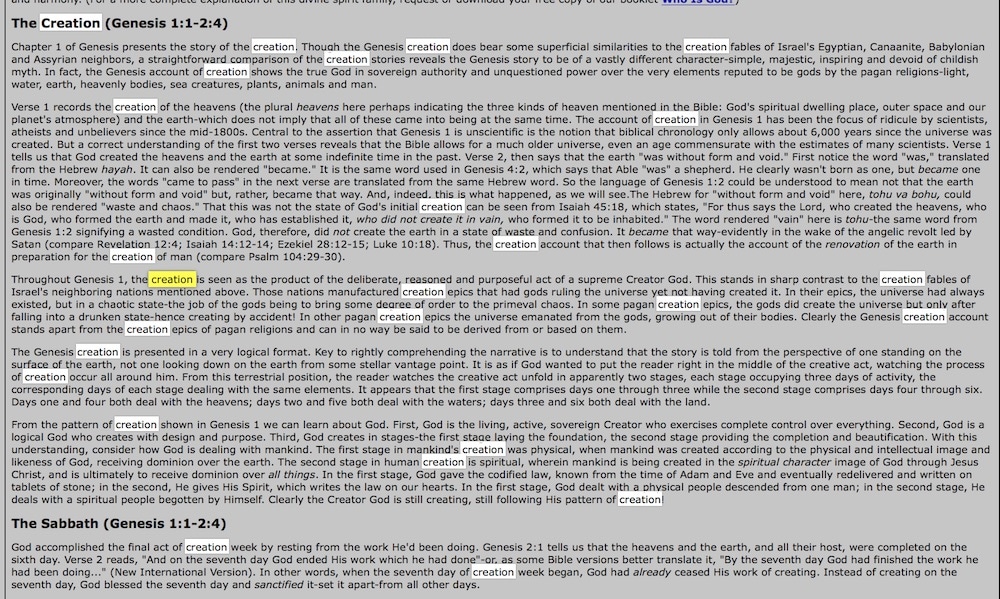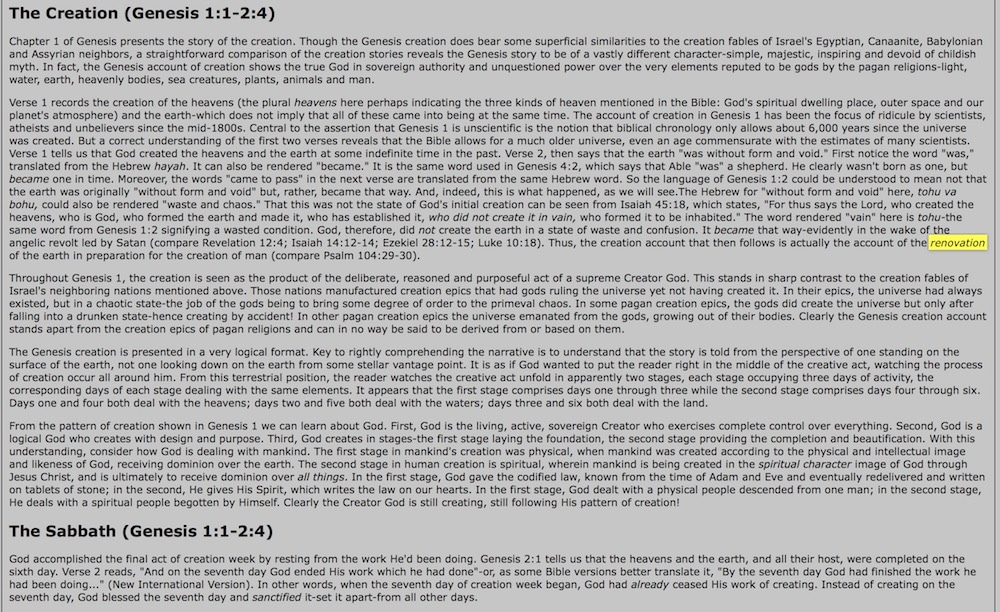“For let not that man suppose that he will receive anything from the Lord; he is a double-minded man, unstable in all his ways.” (Jas 1:7-8)
Chapter 1
The gap theory’s
distortion of language
SYNOPSIS: When did time begin? – The Sabbath day: a memorial to a re-creation? – God’s words can be equivocated (ie. they are subject to change in a covert manner)? – An inconsistent doctrine that demands ambiguity – Reason and logic are disregarded and confusion reigns.
In order for anyone to consider the gap theory as the true history of the earth, they must first accept that throughout the Bible – from Genesis to Revelation – the fundamental meaning of certain words can be altered with no explanation necessary. For example, the word “creation” must be interchangeable with “re-creation”, and the word “made” must be interchangeable with the word “re-made”. The problem, however, is that it is just not possible to swap the meanings of these words, in either the Hebrew or the Greek or indeed English, with consistency, because any attempt to do so would nullify, or turn into nonsense, other related Scriptures. Thus, any doctrine that follows this unstable path must be as sketchy and ambiguous in all its manifestations, which is what I document in this chapter.
(Note: In Chapter 8, ‘Six Biblical Conundrums of the Gap Theory’, I consider the gap creation arguments for the Hebrew words bara, hayah, tohuw, bohuw, and asah. In this chapter, I am only dealing with the basic logic of language restraints, and the need to accept the clarity and consistency present in God’s word as found in good Bible translations such as the KJV.)
Now let us look at the most obvious example. If we were to swap the word “creation” for “initial creation” and “re-creation”, and the word “made” for “re-made”, in Genesis 1 and 2 according with the doctrine of the gap theory, this is what we would read:
“In the beginning God created the initial heavens and the earth… Then God re-made two great lights: the greater light to rule the day, and the lesser light to rule the night. He re-made the stars also. … Then God saw everything that He had re-made, and indeed it was very good. So the evening and the morning were the sixth day… Then God blessed the seventh day and sanctified it, because in it He rested from all His work which God had re-created and re-made.” (Gen 1:16, 31; Gen 2:3).
And if we work our way into the New Testament, and try to swap “created” with “re-created”, and “made” with “re-made”, once again we have another unbiblical distortion.

“But from the beginning of the re-creation God re-made them male and female.” (Mark 10:6)
No gap creationist would ever openly state this. That is why they read what the Bible says but privately attribute different meanings to some of the words and thus change the straightforward intent of the Scriptures. This practice of altering the meaning of words in the same context inconsistently and at will is an example of equivocation. Bible students who view the Scriptures as their primary source of truth would recognise this as enough evidence to abandon any gap theory ideas.
Thus, understanding the true creation account is not a question of biblical scholarship (i.e. having a special understanding of Hebrew words), it is a matter of being consistent – not double minded – when reading and quoting the word of God. It is also a matter of believing exactly what God has told us without changing it to fit a man-made doctrine specifically designed to accommodate a modern secular worldview of an ancient earth.
Christ is the Word “the Logos” and we simply cannot change the words he has given us in an attempt to make sense of any doctrine that appeals to us and which we have adopted.
More importantly, it is a matter of FAITH. That is, having faith in the precise words God commanded Moses to write down when recording the Scriptures. And not just the words, the accurate historical accounts also, as illustrated in the Book of Numbers:
“These are the journeys of the children of Israel, who went out of the land of Egypt by their armies under the hand of Moses and Aaron. Now Moses wrote down the starting points of their journeys at the command of the LORD. And these are their journeys according to their starting points…” (Num 33:1-2)
And before anyone uses the argument that we can’t rely on the accuracy of the Bibles we have today, there are two crucial points to consider.
1: If God is incapable of preserving his word throughout history, we have no assurance of anything in Scripture and our faith would be resting on shifting sand. Yet Jesus – the Word – stated, “Thy word is true from the beginning”(Ps 119:60), and that God’s people would be “sanctified” through truth (John 17:17), and Jesus would build his church on rock and it would not be overpowered (Matt 16:18).

2: Even though the last 140 years have witnessed the entry of many corruptions in modern Bible versions, we still have access to the Byzantine Majority Text manuscripts, which constitute 95 per cent of the most widely circulated New Testament manuscripts in existence today. (This is more historical evidence than that of any other ancient document on earth.) As for the Old Testament, all world renowned Hebrew scholars today confirm that the Genesis creation account in the Masoretic text was written as a continuous flowing narrative – with NO gap. (Refer to Chapter 8, ‘Six Biblical Conundrums of the Gap Theory’.)
The meaning of equivocation
Here I expand on the definition of equivocation, taken from a Glossary of Grammatical and Rhetorical Terms (emphases added):
“Equivocation is a fallacy by which a key word or phrase in an argument is used with more than one meaning. … Also known as semantic equivocation.
“In a broader sense, equivocation refers to the use of vague or unclear language, especially when the intention is to mislead or deceive an audience.” (www.thoughtco.com/equivocation-fallacy-term-1690672)
Looking at the word “equivocation” in a thesaurus we find synonyms such as “deceptiveness, duplicity, fallacy, fibbing and misinterpretation”. And when we look at the antonyms for “equivocation”, we are given words including “truthfulness, trustworthiness, uprightness and honesty”.
(Important clarification: please note, I am not claiming that all those who believe/teach the gap theory are deliberately misleading people. However, it IS a doctrine that can only appear plausible when kept as vague as possible whenever reference is made to it.)

With this definition of equivocation in mind, it would seem that anyone who cares about the truth and sanctity of God’s word, and who has the responsibility to teach it, would be well advised to stay clear of utilising this misleading and deceptive literary device.
That is, quoting God’s word and then implying another meaning, quite different from the original Hebrew found in the Old Testament manuscripts and, in fact, not used in any Bible version.
The gap theory is dependent on equivocation – example one:
The gap theory is an example of the systematic employment of equivocation, because it relies on swapping the meaning of words – words that are not interchangeable, as any English student would know. To illustrate this, I have chosen just four examples of equivocation. But first, let us see how God describes the matter of creation and time:
“For in six days the LORD made the heavens and the earth, the sea, and all that is in them, and rested the seventh day. Therefore the LORD blessed the Sabbath day and hallowed it.” (Ex 20:11)
“Then God said, ‘Let Us make man in Our image, according to Our likeness’ … Then God saw everything that He had made, and indeed it was very good. So the evening and the morning were the sixth day.” (Gen 1:26-31) … “But from the beginning of the creation, God ‘made them male and female’.” (Mark 10:6; Gen 1:27; Gen 5:2)… “And He said to them, ‘The Sabbath was made for man, and not man for the Sabbath.’” (Mark 2:26)

There is no equivocation or ambiguity here. God tells us time began on Day One of the creation process. Man was created in His image on Day Six, and the Sabbath was instituted on the first-ever Seventh Day, as a memorial to God’s act of creation, when He rested from all His labours.
Now if we look at the teachings taken from the media of one church organisation, which dogmatically and exclusively teaches the gap theory, we are told the following:
“The Sabbath was created right there at the very beginning” … “…the beginning, when time started to be counted on Day 1” (Refer www.ucg.org/beyond-today/beyond-today-television-program/remembering-the-sabbath, and Beyond Today magazine, July-Aug 2018, page 10.)
On the surface, this appears to be confirming the biblical account. In reality, however, nothing could be more confusing in this statement. This is because Day 1, in this church’s creation story, is Day 1 of a RE-creation period, and the “very beginning” of time is said to have commenced 13.7 billion years earlier at the birth of the universe, in accordance with the timeline and epochs of evolutionary geology and cosmology. (Refer ‘Creation or Evolution: Does It Really Matter What You Believe?’, United Church of God, booklet available to download online.)
This church also teaches that the earth (in fact, the whole universe) was totally demolished by the devil sometime during this planet’s claimed 4.6-billion-year history, and then “RE-made” by God 6000 years ago at the beginning of the “age of man” (their words). That means, in this scenario, the Sabbath, which Jesus said was “made for man” (Mar 2:27), was NOT “right there at the beginning [of creation] …when time started to be counted” at all (as stated in this church’s media). Rather, the Sabbath is attributed to a day commemorating a recent “renovation” (another term used in gap creation). This “renovation” is said to have taken place 4.6 billion years AFTER the creation of the earth and 13.7 billion years AFTER the beginning of time, at the claimed secular event of the big bang. These events, however, are never placed onto a timeline, which would immediately reveal the contradictions and confusion in the gap theory.
And so, the above quoted statement, about the Sabbath being there at the beginning of time, doesn’t make sense on any level in the gap theory. This is a prime example of semantic equivocation – “a fallacy by which a key word or phrase in an argument is used with more than one meaning… with the intention to mislead an audience”.
Second Example of Equivocation
Another example of equivocation can be heard in a short-film creation narrative for children, produced by the same church, which not only proclaims the gap theory but also despises the teaching of young earth creation in no uncertain terms. The singer in this film is a Muppet-like character called Jelly. Here is the transcript, where every word that should say “re-made”, in accordance with this church’s gap theory belief, is equivocally being stated as “made”.

“Ahem. God made the earth in seven days, seven days, seven days, God made the earth in seven days, God made the earth! The first day He made the light, made the day, made the night, the first day He made the light, God said ‘That’s good!’ The second day He made the sky, all the clouds sailing high, the second day He made the sky, God said ‘That’s good!’
“The third day He made the land and the plants, it was grand! The third day He made the land, God said ‘That’s good!’ God made the earth in seven days, seven days, seven days, God made the earth in seven days, God made the earth. The fourth day He made the lights, sun by day, moon by night, the fourth day He made the lights, God said ‘That’s good!’ The fifth day He gave the word, swimming fish, flying birds, the fifth day He gave the word, God said ‘That’s good!’
“The sixth day He made the life, animals, man and wife, the sixth day He made the life, God said ‘That’s good!’ The seventh day He took a rest, sabbath day, it was blest, the seventh day He took a rest, God took a rest. Oh, God made the earth in seven days, seven days, seven days, God made the earth in seven days, God made the earth.” (www.ucg.org/jelly/jelly-and-the-days-of-creation)
Almost every eighth word in this song is an equivocation – having changed its meaning while pretending it has not (ie. using the biblical word made while teaching that it really means “re-made“).
Not only that, but the children watching this film would never know this is all about a re-creation – a doctrine this church sees as crucial in order to explain the devil’s rebellion and why evil exists in the world (as I explore in the next chapter – ‘Origin of the Devil’).
And there is something else. This song claims that “God made the earth in seven days”, which is a blatant violation of Scripture, because the Bible tells us “in six days the LORD made heaven and earth….” (Ex 20:11).
No wonder God instructs us that it is not good enough to “receive the word with all readiness”, but we must also “search the Scriptures daily to find out whether these things [are] so” (Acts 17:11). This is because what we are being told in a church, or by a minister, may not be true, as we can see here.
All this is important, considering the ministry of this particular church has publicly condemned the young earth creation narrative as a “satanic heresy” of the highest order, which must never be discussed among the members or they will be asked to leave. Other churches or individual gap theorists may not be that dogmatic, but the arguments regarding equivocation are the same.
It is also ironic that these gap-theory claims are coming from a church organisation that worships on the Sabbath day – but not according to the biblical explanation, which, once again, has to be (secretly) equivocated. Below, I state what Ex 20:11 REALLY means in this theology, although it is NEVER expressed openly as such.
“For in six days the LORD RE-made heaven and earth, the sea, and all that in them is, and rested the seventh day of the renovation: wherefore the LORD blessed the sabbath day, and hallowed it.” (Ex 20:11)

Referring to yet other equivocations expressed in this church’s material, the six-day creation account (as clearly defined in Scripture) has been REJECTED.
And it has been REPLACED with a six-day period, in which God inexplicably “set [the creation] in order” and “moulded the planet”.
I say “inexplicably” because there are seven references to the “creation” in this 40-page booklet (quoted below) but not one mention of the gap theory to explain what these words are meant to communicate. And so the reader is left with the following cryptic, recondite, equivocal explanation:
“After six days of setting in order this beautiful earth and everything in it, our Creator ceased from molding the physical part of His creation and rested on the seventh day (Genesis 2:1-3)… On the Sabbath we are to take the day off from our regular activities and devote our time and attention to our Creator. Why? Because in six days God set in order “the heavens and the earth, the sea, and all that is in them, and rested the seventh day. Therefore the Lord blessed the Sabbath day and hallowed it.” (Exodus 20:11) (United Church of God, The Ten Commandments, pp31-32.)
In yet another of this church’s publications, the 64-page booklet Sunset to Sunset, God’s Sabbath Rest, there is not one mention of an “initial earth”, a “re-creation”, a “renovation”, “setting in order” the earth and “moulding” the heavens, or any other gap theory term. Rather, we are repeatedly told about the “six days of creation week” and the “creation commemoration” because “God made the Sabbath holy at creation”, when in reality, this church vehemently denies all of this.
And the equivocations/ inconsistencies continue, such as when a minister wants to draw specific attention to the matter of the gap theory in a sermon. On occasion, he will clearly refer to the “renovation” – knowing full well it has a different meaning to creation, which is precisely why he uses this word. But after he has made his point, that same minister will once again return to using the biblical word “creation”. Such communications are fundamentally dishonest, yet acceptable to many Christians. How can this be when God instructs his people of the need to “recognise the Spirit of Truth and the spirit of falsehood” (1 John 4:6)?
These examples of equivocation (applying the spirit of falsehood) are similar, in practice, to that of ministers who preach theistic evolution.
I know, because I used to attend such a church. There the pastor would deliver an entire sermon on the glorious creation account and how the first man and woman were created from the dust of the earth, as laid out in the first two chapters of Genesis, when in reality he didn’t believe a word of it.
To the listener, it appeared to be the biblical truth of how God created, when all the while the minister saw it as a myth, a fable, a poetic narrative that did not have to be taken literally – ie. a non-truth. Yet he never explained this to the congregation.

The dictionary meaning of Equivocation shows it is the antithesis of clarity:
“deliberate evasiveness in wording : the use of ambiguous or equivocal language ‘Like any good teacher, he does his best to answer with clarity and minimal equivocation’ – Eric Bugyis.” (Merriam-Webster Dictionary)
“allowing the possibility of several different meanings, as a word or phrase, especially with intent to deceive or misguide; susceptible of double interpretation; deliberately ambiguous.” (http://www.dictionary.com/browse/equivocal)
There is not a single case of equivocation found in Scripture (that is, except possibly in Isaiah 28:1-13, where God is mocking the ‘wise’). Nevertheless, the gap theory cannot exist without it.
equivocation example three
Another example of equivocation is taken from an online Bible Commentary from the same church, which mandates acceptance of the gap theory for its members: Under the heading ‘Introduction to Genesis 1:1-2:4’, there are 25 references to the “creation”. (See screengrab below)

However, this church categorically rejects the teaching that Genesis 1:1-31 describes the CREATION. In other words, almost every reference to the “creation” stated above really means “renovation”. We see this half way through this section of the commentary, where we are told that Gen 1:2 to Gen 2:4 is “actually a renovation”.
“Thus, the creation account that then follows is actually the account of the renovation of the earth.” (see below).

After which this Bible commentary goes back to the Bible’s description of CREATION week again (see above), even though this church KNOWS that the teaching of this being a creation is in stark contrast to its teaching about a “RE-creation or” “renovation”.
“God accomplishes the final act of creation week by resting … In other words, when the seventh day of creation week began, God had already ceased His work of creating.” (bible.ucg.org/bible-commentary/Genesis/Creation;-Earth’s-six-day-renovation;-The-Sabbath)
When trying to point this equivocation out to a gap theory friend, their reply was “create or re-create, it’s the same thing”. Firstly, these words do not mean the same thing. The Merriam-Webster Dictionary describes the difference: “Create: to bring into existence”; “Recreate: to create again, to form anew”. And to clarify this further, let’s look the other word gap creation employs – “Renovation: to restore to a former better state (as by cleaning, repairing, or rebuilding)”.
Secondly, if, for argument’s sake, the words Create and Re-create/Renovate did mean the same thing, why not make it clear which meaning is implied so everyone else can understand what is being communicated, especially when it is deemed such an important doctrine?
And I challenge the writers of the above-mentioned Bible Commentary on Genesis to do just that – to be consistent and clear by using the word they mean, not the word they don’t mean!
This equivocal practice of slipping and sliding between two completely different concepts is endemic in the gap theory!
example four: OMITTING SCRIPtURES TO THE CONTRARY
Another practice of those who advocate gap creation is to omit the Scriptures that don’t fit the theory. This is the same with theistic evolution, because the very nature of all old-earth theories is that they are incapable of joining all the biblical pieces together. Once someone tries to do this, they will see they don’t fit. And I can only surmise that certain “inconvenient” Scriptures are ignored for one of two reasons.
1: The communicators themselves are sincere but they do not see a need for their arguments to fit together cohesively. This is because they are already convinced they are right and so they can live comfortably with inconsistencies.
2: The other reason is that such a communicator can feel a sense of superiority in appearing more knowledgeable than other people through their ability to “find special revelation or knowledge in the Scriptures”. Thus they are able to lead those who are susceptible to equivocal language and double interpretations around in endless philosophical circles.
One gap creationist I spoke to told me that the secrets of the gap theory are only known to those whom God has revealed them to. And if you don’t understand it, it is a sign you don’t know God.
Whatever the heart and intention of such gap creation proponents, only God knows, but passionate advocates of gap creation, by necessity, have to destroy the path of both logical and biblical reasoning to defend their chosen creation model.
Below is another example of what I mean:

When Jesus was contending with a group of antagonistic Jews who would not believe what he said, he challenged them and provided one of the most descriptive Scriptures in the Bible about the character of the devil:
“Why do you not understand My speech? Because you are not able to listen to My word” … [The devil] was a murderer from the beginning, and does not stand in the truth, because there is no truth in him. When he speaks a lie, he speaks from his own resources, for he is a liar and the father of it.” (John 8:43-44)
To emphasise this point, the apostle John reiterates Jesus’s words.
“He who sins is of the devil, for the devil has sinned from the beginning. For this purpose the Son of God was manifested, that He might destroy the works of the devil.” (1 John 3:8)
The Hebrew word for “beginning” here is arche and it means “beginning, origin, absolutely, of the beginning of all things”. To my knowledge, however, this crucial characterisation of Satan is not referred to in gap creation material, which is all about the devil! (An example: the 72-page booklet quoted above, ‘Creation or Evolution Does It Really Matter What You Believe?’, and other material from the same church, make no mention of this fact.) And it is no surprise why, because how can Jesus’s description of the devil being a liar and “a murderer from the beginning” be true if the gap theory – which teaches that the devil was NOT a liar and murderer from the very beginning, or in fact for millions/billions of years – is true?
There is also the matter of Jesus’s clear teaching in Mark 10:6, when, once again, he was contending with those who refused to believe his words. Here he was speaking to the Pharisees, who were trying to test Him on the matter of divorce. In reply, Jesus explained that the law of Moses permitted divorce because of the hardness of the people’s hearts. Then he made an unequivocal statement – that man was made at the beginning of the CREATION (ie. creation week).
“But from the beginning of the creation, God ‘made them male and female’.” (Mark 10:6)
Neither of the verses are convenient in gap creationism, which teaches that God made man 13.7 billion years after He created the heavens and the earth.
Not listening to Jesus’s words in order to defend any doctrine is yet another example of not being honest with Scripture.

Now let us take a moment to think this matter through, because if the gap theory is true it has to make sense –biblically and also logically:
- One of the gap theory’s leading arguments is that the devil NEEDED millions or billions of years to commit sin. But if we look to the Bible, this argument is without any foundation. Why? Because it did not take Adam very long at all to bring sin into a sinless creation (Gen 3:17).
- Likewise, there is no reason to believe that it would take one third of the angels, who shared the same rebellious spiritual nature of Lucifer, million or billions of years to sin, either.
- And had the devil sinned at the beginning of “initial creation” and ascended into heaven to wage war against God, and God had cast him down to the earth with the angels who had also sinned at the beginning, what then was happening on earth for the next 4.6 billion years according to the timescale the gap theory has accepted? And more importantly, what purpose would God have had to allow this chaos and confusion on the earth for all this time?
- If the gap theory were true, why would Jesus have called the devil “a murderer from the beginning” Who did the devil murder? After all, man did not come into existence for another 13.7 billion years, according to gap theory doctrine, and spirit beings can’t be murdered.
In this chapter, I have provided just four examples of using vague and confusing communications – in the form of plainly quoting the words of Scripture on one hand while duplicitously and covertly changing their meaning on the other, as well as the problem of employing deficient arguments. The Bible has two words for this – double-mindedness and instability and it is not referred to in a positive light (Jas 1:8;4:8).
Now I will embark on an exploration of the gap theory, which begins with the story of the devil and his claimed part in the creation narrative and God’s plan.
Reiterating – the gap theory is fundamentally an inconsistent doctrine that is wholly reliant on applying double talk and double meanings to God’s word. Those who teach this doctrine may not be aware of this fact, thus I do not cast any accusation on any of them that they do this knowingly – most teach it as they have been taught. This discordant doctrine, however, does not reflect the God of the Bible, who tells us He did not communicate with Moses (who penned the Genesis creation account) in “riddles” or “dark” enigmatic speeches, but “clearly” and in “plain language” (Num 12:8).
Images: iStock.com/CrossEyedPhotography; iStock.com/francescoch; Jon Schulte/Shutterstock.com; KN/Shutterstock.com; Lightstock; mpaniti/Shutterstock.com; Oleksandrum/Shutterstock.com; Pixabay; Wikicommons.

“Draw near to God and He will draw near to you. Cleanse your hands, you sinners; and purify your hearts, you double-minded.” (Jas 4:8)
